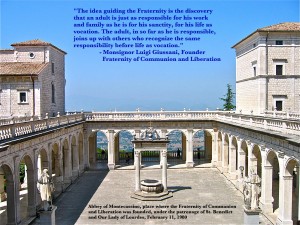 May Our Lady of Lourdes and Saint Benedict intercede for the good of the Fraternity of Communion and Liberation here in the USA, and around the world.
May Our Lady of Lourdes and Saint Benedict intercede for the good of the Fraternity of Communion and Liberation here in the USA, and around the world.
Saint Scholastica
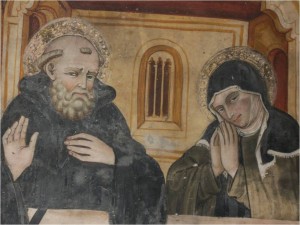 From the Dialogues by Saint Gregory the Great:
From the Dialogues by Saint Gregory the Great:
Scholastica, the sister of Saint Benedict, had been consecrated to God from her earliest years. She was accustomed to visiting her brother once a year. He would come down to meet her at a place on the monastery property, not far outside the gate.
One day she came as usual and her saintly brother went with some of his disciples; they spent the whole day praising God and talking of sacred things. As night fell they had supper together.
Their spiritual conversation went on and the hour grew late. The holy nun said to her brother: “Please do not leave me tonight; let us go on until morning talking about the delights of the spiritual life.” “Sister,” he replied, “what are you saying? I simply cannot stay outside my cell.”
When she heard her brother refuse her request, the holy woman joined her hands on the table, laid her head on them and began to pray. As she raised her head from the table, there were such brilliant flashes of lightning, such great peals of thunder and such a heavy downpour of rain that neither Benedict nor his brethren could stir across the threshold of the place where they had been seated. Sadly he began to complain: “May God forgive you, sister. What have you done?” “Well,” she answered, “I asked you and you would not listen; so I asked my God and he did listen. So now go off, if you can, leave me and return to your monastery.”
Reluctant as he was to stay of his own will, he remained against his will. So it came about that they stayed awake the whole night, engrossed in their conversation about the spiritual life.
It is not surprising that she was more effective than he, since as John says, God is love, it was absolutely right that she could do more, as she loved more.
Three days later, Benedict was in his cell. Looking up to the sky, he saw his sister’s soul leave her body in the form of a dove, and fly up to the secret places of heaven. Rejoicing in her great glory, he thanked almighty God with hymns and words of praise. He then sent his brethren to bring her body to the monastery and lay it in the tomb he had prepared for himself.
Their minds had always been united in God; their bodies were to share a common grave.
Blessed (Saint) José Sánchez del Río
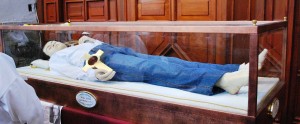 Besides being the beginning of Lent and the feast day of the great Saint Scholastica, twin sister of Saint Benedict, it is the feast day of the remarkable Blessed (soon-to-be Saint) José Sánchez del Río. The pious mantra that comes to mind is ¡VIVA CRISTO REY! when one thinks of this holy man. Recall the anti-Catholic government soldiers said: “If you shout, ‘Death to Christ the King’, we will spare your life.” His response: He only answered: “Long live Christ the King! Long live Our Lady of Guadalupe!”
Besides being the beginning of Lent and the feast day of the great Saint Scholastica, twin sister of Saint Benedict, it is the feast day of the remarkable Blessed (soon-to-be Saint) José Sánchez del Río. The pious mantra that comes to mind is ¡VIVA CRISTO REY! when one thinks of this holy man. Recall the anti-Catholic government soldiers said: “If you shout, ‘Death to Christ the King’, we will spare your life.” His response: He only answered: “Long live Christ the King! Long live Our Lady of Guadalupe!”
At 13, José was the flag-bearer in the Cristero army fighting (fiercely fighting in mid-1920s) for the right to remain Catholic in the face of anti-religious government policies. Also serving the Cristero army were two older brothers, Macario and Miguel. Mexican government troops captured José and imprisoned, abused, mutilated, him having ordered the young man to reject Jesus Christ and His Church on this date in 1928. José refused and was given the martyr’s crown. The details of his death are gruesome: he hacked with machetes, stabbed with bayonets and finally shot on 10 February 1928 in Sahuayo, Michoacán de Ocampo, Mexico.
The body of the saint is interred in the Church of the Sacred Heart of Jesus, Sahuaro, Mexico with a bone fragment relic enshrined in the church of the Immaculate Conception, Taft, Texas.
Barely seen in this image one sees Pope Benedict praying before the tomb of the Saint José Sánchez del Río when he visited Mexico. It was Benedict who declared him a martyr and who beatified José on November 20, 2005. Pope Francis will declare him a saint 2016.
May Saint José Sánchez del Río show us how to live the virtue of fortitude in the face of hardship.
Ash Wednesday
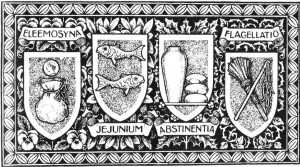 Ash Wednesday the first day of Lent. On this day, the observance of fast and abstinence begins. Pope St. Leo teaches that the main purpose for fasting is not that the body be deprived of food, but that the mind at the same time be withdrawn from wickedness, we should endeavor during Lent, not only to be temperate in eating and drinking, but especially to lead a modest life, sanctifying the days by persevering prayer and devoutly attending the Church’s liturgy.
Ash Wednesday the first day of Lent. On this day, the observance of fast and abstinence begins. Pope St. Leo teaches that the main purpose for fasting is not that the body be deprived of food, but that the mind at the same time be withdrawn from wickedness, we should endeavor during Lent, not only to be temperate in eating and drinking, but especially to lead a modest life, sanctifying the days by persevering prayer and devoutly attending the Church’s liturgy.
Saint Josephine Bakhita
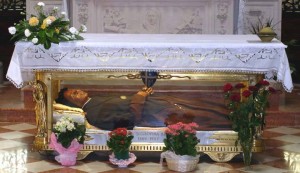 I posted this text last year but I thought it was so good that I’d do it again…. Pope Benedict XVI in his encyclical on Hope, Spes Salvi gave Saint Josephine Bakhita as an oustanding example of one who discovered Christian hope.
I posted this text last year but I thought it was so good that I’d do it again…. Pope Benedict XVI in his encyclical on Hope, Spes Salvi gave Saint Josephine Bakhita as an oustanding example of one who discovered Christian hope.
3. Yet at this point a question arises: in what does this hope consist which, as hope, is “redemption”? The essence of the answer is given in the phrase from the Letter to the Ephesians quoted above: the Ephesians, before their encounter with Christ, were without hope because they were “without God in the world”. To come to know God—the true God—means to receive hope. We who have always lived with the Christian concept of God, and have grown accustomed to it, have almost ceased to notice that we possess the hope that ensues from a real encounter with this God. The example of a saint of our time can to some degree help us understand what it means to have a real encounter with this God for the first time. I am thinking of the African Josephine Bakhita, canonized by Pope John Paul II. She was born around 1869—she herself did not know the precise date—in Darfur in Sudan. At the age of nine, she was kidnapped by slave-traders, beaten till she bled, and sold five times in the slave-markets of Sudan. Eventually she found herself working as a slave for the mother and the wife of a general, and there she was flogged every day till she bled; as a result of this she bore 144 scars throughout her life. Finally, in 1882, she was bought by an Italian merchant for the Italian consul Callisto Legnani, who returned to Italy as the Mahdists advanced. Here, after the terrifying “masters” who had owned her up to that point, Bakhita came to know a totally different kind of “master”—in Venetian dialect, which she was now learning, she used the name “paron” for the living God, the God of Jesus Christ. Up to that time she had known only masters who despised and maltreated her, or at best considered her a useful slave. Now, however, she heard that there is a “paron” above all masters, the Lord of all lords, and that this Lord is good, goodness in person. She came to know that this Lord even knew her, that he had created her—that he actually loved her. She too was loved, and by none other than the supreme “Paron”, before whom all other masters are themselves no more than lowly servants. She was known and loved and she was awaited. What is more, this master had himself accepted the destiny of being flogged and now he was waiting for her “at the Father’s right hand”. Now she had “hope” —no longer simply the modest hope of finding masters who would be less cruel, but the great hope: “I am definitively loved and whatever happens to me—I am awaited by this Love. And so my life is good.” Through the knowledge of this hope she was “redeemed”, no longer a slave, but a free child of God. She understood what Paul meant when he reminded the Ephesians that previously they were without hope and without God in the world—without hope because without God. Hence, when she was about to be taken back to Sudan, Bakhita refused; she did not wish to be separated again from her “Paron”. On 9 January 1890, she was baptized and confirmed and received her first Holy Communion from the hands of the Patriarch of Venice. On 8 December 1896, in Verona, she took her vows in the Congregation of the Canossian Sisters and from that time onwards, besides her work in the sacristy and in the porter’s lodge at the convent, she made several journeys round Italy in order to promote the missions: the liberation that she had received through her encounter with the God of Jesus Christ, she felt she had to extend, it had to be handed on to others, to the greatest possible number of people. The hope born in her which had “redeemed” her she could not keep to herself; this hope had to reach many, to reach everybody.
The concept of faith-based hope in the New Testament and the early Church
4. We have raised the question: can our encounter with the God who in Christ has shown us his face and opened his heart be for us too not just “informative” but “performative”—that is to say, can it change our lives, so that we know we are redeemed through the hope that it expresses? Before attempting to answer the question, let us return once more to the early Church. It is not difficult to realize that the experience of the African slave-girl Bakhita was also the experience of many in the period of nascent Christianity who were beaten and condemned to slavery……
5. We must add a further point of view. The First Letter to the Corinthians (1:18-31) tells us that many of the early Christians belonged to the lower social strata, and precisely for this reason were open to the experience of new hope, as we saw in the example of Bakhita……,
National Marriage Week
 “National Marriage Week (Feb. 7-14) and World Marriage Sunday/Valentine’s Day (Sunday, Feb. 14) provide an opportunity to celebrate the gift and blessing of marriage and to affirm and support engaged and married couples.”
“National Marriage Week (Feb. 7-14) and World Marriage Sunday/Valentine’s Day (Sunday, Feb. 14) provide an opportunity to celebrate the gift and blessing of marriage and to affirm and support engaged and married couples.”
Bishop Richard Malone
Chairman of the USCCB Committee on Laity, Marriage, Family Life,and Youth
“Marriage, both as a natural institution and as a Christian sacrament, is an irreplaceable good for society and all people,” wrote Bishop Richard J. Malone of Buffalo, New York, in a letter to his brother bishops. “Our Committee remains ever grateful for the ongoing efforts in dioceses and parishes to promote, strengthen and defend marriage, and to accompany married couples in their joys and trials.”
A prayer resource is found here.
Put into the deep
 In the Ordinary Form of the Mass it is the 5th Sunday through the Year. The Gospel is Luke 5:1-11. In the Byzantine Church it is Cheesefare Sunday (also called forgiveness Sunday). The Byzantine Church prepares its faithful to move slowly into the Lenten observance by three weeks of growing more and more into prayer, fasting and giving alms. While the gospel readings for the various liturgical rites may differ, it is always important to hear the lesson Jesus offers: follow me, watch what I do: put yourself at the mercy of God the Father and the holy desires of your will be made real which in turn will build God’s Kingdom. Lent is almost here. Will we put into the deep?
In the Ordinary Form of the Mass it is the 5th Sunday through the Year. The Gospel is Luke 5:1-11. In the Byzantine Church it is Cheesefare Sunday (also called forgiveness Sunday). The Byzantine Church prepares its faithful to move slowly into the Lenten observance by three weeks of growing more and more into prayer, fasting and giving alms. While the gospel readings for the various liturgical rites may differ, it is always important to hear the lesson Jesus offers: follow me, watch what I do: put yourself at the mercy of God the Father and the holy desires of your will be made real which in turn will build God’s Kingdom. Lent is almost here. Will we put into the deep?
“The Church is called out into the deep, delving, as it were, into the profound mysteries of the heavens, into that depth concerning which the Apostle says, ‘O the depth of the riches and wisdom and knowledge of God!’ For this reason he says to Peter, ‘Put out into the deep,’ – that is to say, into the depths of reflection upon the divine generation. For what is more profound than what Peter says to the Lord, ‘You are the Christ, the Son of the living God?’” –St. Maximus of Turin:
What is meant by “sustainability” by Christians?
We are snowed-in today. The weather is treacherous with the snow and wind outside that I have been able to think about some other things today. Snow days are good for the soul. The recent years have found me thinking more and more about the reasonableness of faith and ecology. The leadership and advocacy for the proper use of the land, air and sea by Patriarch Bartholomew (Constantinople), Pope Benedict XVI and now Pope Francis have raised some good questions about the coherent Christian response to the needs of our environment. These religious leaders have provided good thinking and ways of proceeding without dipping into the reigning ideologies of the political left. For example, Benedict raised the horizons and limitations between human and environmental ecologies. Fast forward, across my computer screen came a very brief note about sustainability by Abbot Tryphon, an abbot in the Orthodox Church living in the Pacific Northwest. For me, the abbot’s words are the beginning of a much larger conversation I am having about the Christian fact of being anointed priest, prophet and king in the Church at baptism, and with Benedictines (monks, nuns and laity) viz. matters of land use, farming, food, as a manner of knowing the Trinity, faith, oneself, and the journey of the self as imago Dei. Benedictines have much to say because their 1500-plus year experiences in these matters of faith and ecology. How do we engage with the land as disciples of Christ in relationship with others?
Abbot Tryphon….
We are, in essence, called to be priests over creation. Sustainability is the current ‘buzzword’ regarding the need for protecting our environment, and is the word being used by environmentalists, governments, businesses, and many average people, as we all face the challenge of saving our world from climate changes, due to the overproduction depletion of the world’s resources. It has been applied to product sourcing, agricultural practices, and technology. It often implies a type of energy that will not—in the foreseeable future—be used up, as some scientists argued was imminent in the case of fossil fuels. It may mean a type of agriculture that doesn’t tax our soil as is being done at the current and alarming rate. The word sustainability is even being applied to waste treatment and water use. These are only a few of the applications that have made use of the phrase ‘sustainable,’ and even in these noted fields the technologies and practices developed have been amazing and immensely beneficial for our culture, humanity in general, and the natural world.
The use of the word “sustainability” is, for us Orthodox Christians, a positive word in relation to our responsibilities as stewards of all that God has given us. It is also a word that people can relate to. Yet despite the laudable achievements within the sustainability movement, there is a dark underside to the usage of the word and the application of the concept. “Sustainable” often means trying to find a “better” way to continue living as we currently do, and often bears within itself an underlying notion of stasis, or remaining the same. For Orthodox Christians, this is unquestionably dangerous.
Imagine a priest upon his deathbed speaking with his confessor about his parish, saying, “Yes, I leave them exactly as I found them; they don’t regularly commit any more sins than when I got to the parish.” Contrast this possibility with, “By the grace of God, they have grown.” All priests are charged with the responsibility of helping their parishioners grow, for there is in fact no such thing in the spiritual life as stasis. If someone is not growing, struggling, and working out his or her salvation, the seeds of degeneration are already planted.
But if we are not ordained priests, we might wonder how this could have anything to do with us. Yet as Orthodox Christians living in the God-created world, we are all, in the deepest sense, priests over creation. His All-Holiness, the Ecumenical Patriarch Bartholomew, said: “Endowed… from the beginning with ‘the image of God,’ humanity is called to continuous self-transcendence so that, in responsible synergy with God the Creator, each person might sanctify the entire world, thus becoming a faithful ‘minister’ and ‘steward.’” We are, in essence, called to be priests over creation, for as ministers of this created universe it is our responsibility to cease doing harm, for our final goal is the transfiguration of creation. The ultimate transformation that must take place within ourselves ultimately brings transformation to the entire cosmos.
St Rabanus Maurus Magnentius
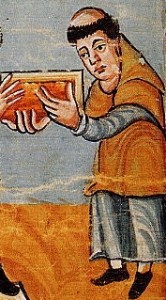 Saint Rabanus Maurus Magnentius (c. 780 – 4 February 856), as a Frankish Benedictine monk, the archbishop of Mainz in Germany and a theologian. In his spare time he authored the encyclopaedia De rerum naturis (On the Nature of Things) and treatises on education, grammar and the Bible.
Saint Rabanus Maurus Magnentius (c. 780 – 4 February 856), as a Frankish Benedictine monk, the archbishop of Mainz in Germany and a theologian. In his spare time he authored the encyclopaedia De rerum naturis (On the Nature of Things) and treatises on education, grammar and the Bible.Andrea Aziani sainthood cause opened
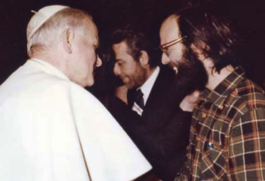 On February 2, during Mass celebrating the 19th anniversary of the Diocese of Carabayllo, in the city of Lima, Peru, Bishop Lino Panizza, announced the opening of the cause of beatification of Andrea Aziani.
On February 2, during Mass celebrating the 19th anniversary of the Diocese of Carabayllo, in the city of Lima, Peru, Bishop Lino Panizza, announced the opening of the cause of beatification of Andrea Aziani.